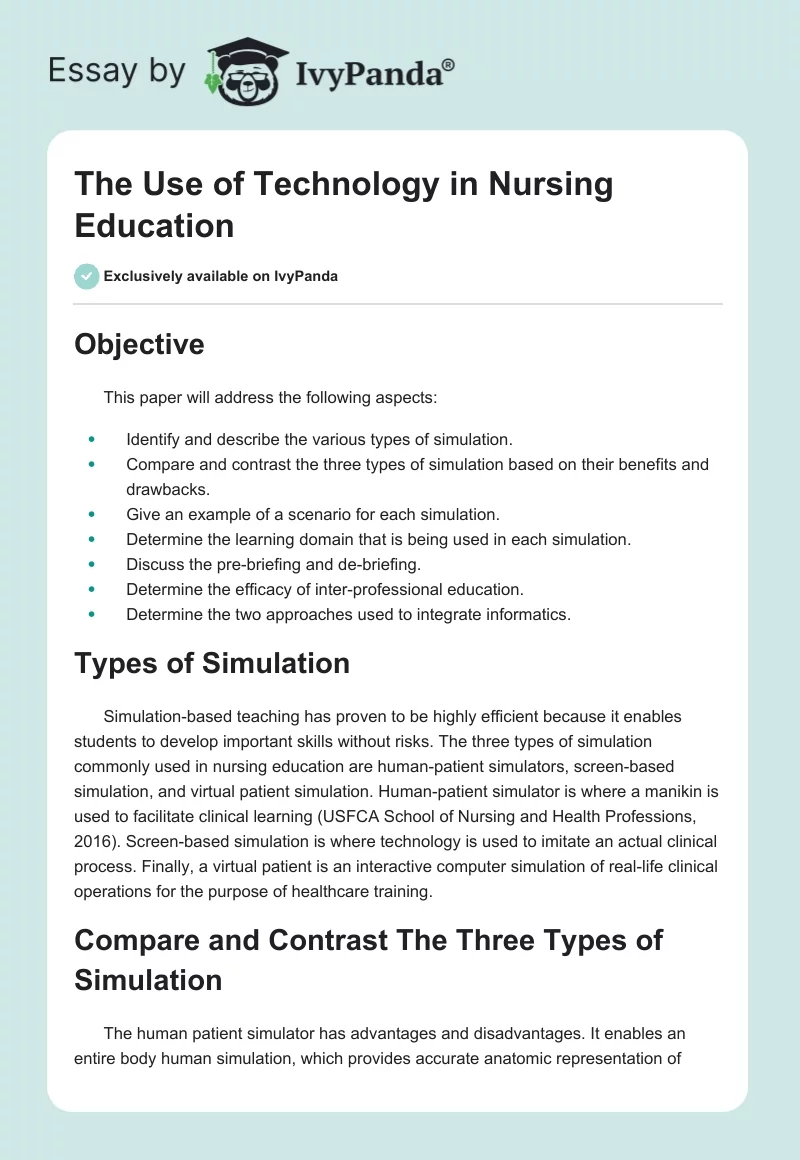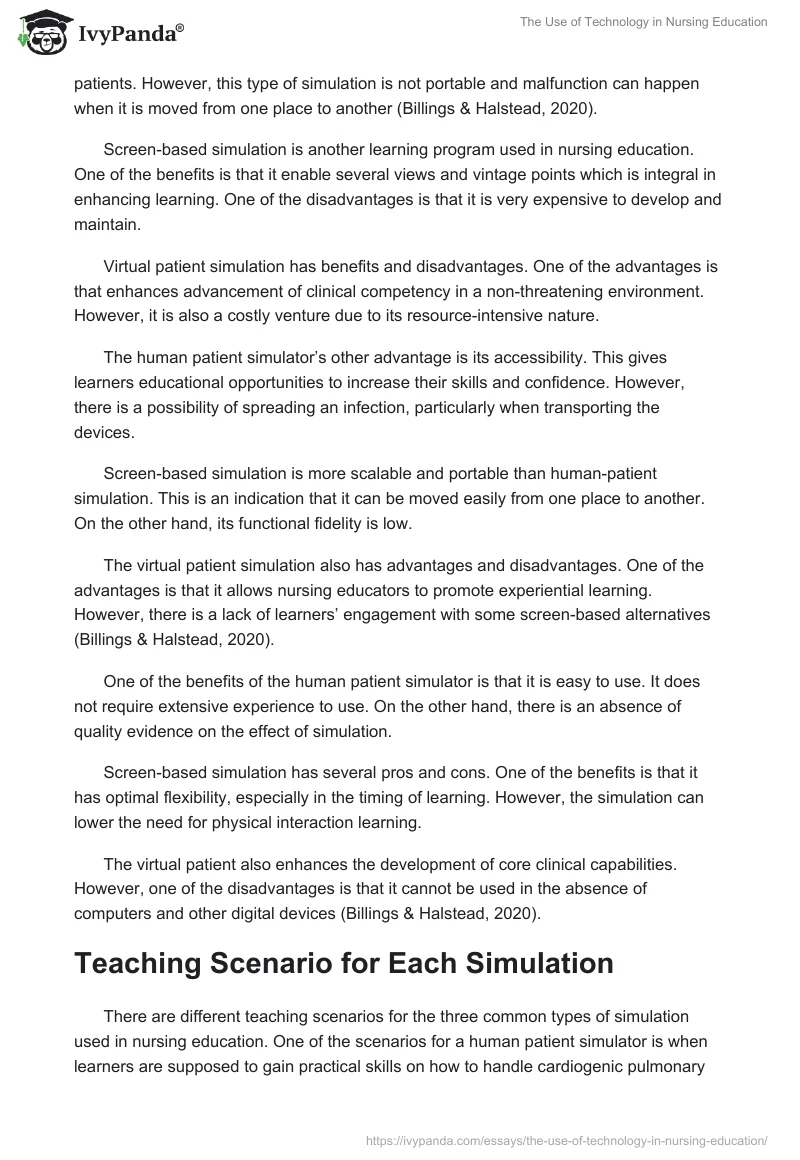Objective
This paper will address the following aspects:
- Identify and describe the various types of simulation.
- Compare and contrast the three types of simulation based on their benefits and drawbacks.
- Give an example of a scenario for each simulation.
- Determine the learning domain that is being used in each simulation.
- Discuss the pre-briefing and de-briefing.
- Determine the efficacy of inter-professional education.
- Determine the two approaches used to integrate informatics.
Types of Simulation
Simulation-based teaching has proven to be highly efficient because it enables students to develop important skills without risks. The three types of simulation commonly used in nursing education are human-patient simulators, screen-based simulation, and virtual patient simulation. Human-patient simulator is where a manikin is used to facilitate clinical learning (USFCA School of Nursing and Health Professions, 2016). Screen-based simulation is where technology is used to imitate an actual clinical process. Finally, a virtual patient is an interactive computer simulation of real-life clinical operations for the purpose of healthcare training.
Compare and Contrast The Three Types of Simulation
The human patient simulator has advantages and disadvantages. It enables an entire body human simulation, which provides accurate anatomic representation of patients. However, this type of simulation is not portable and malfunction can happen when it is moved from one place to another (Billings & Halstead, 2020).
Screen-based simulation is another learning program used in nursing education. One of the benefits is that it enable several views and vintage points which is integral in enhancing learning. One of the disadvantages is that it is very expensive to develop and maintain.
Virtual patient simulation has benefits and disadvantages. One of the advantages is that enhances advancement of clinical competency in a non-threatening environment. However, it is also a costly venture due to its resource-intensive nature.
The human patient simulator’s other advantage is its accessibility. This gives learners educational opportunities to increase their skills and confidence. However, there is a possibility of spreading an infection, particularly when transporting the devices.
Screen-based simulation is more scalable and portable than human-patient simulation. This is an indication that it can be moved easily from one place to another. On the other hand, its functional fidelity is low.
The virtual patient simulation also has advantages and disadvantages. One of the advantages is that it allows nursing educators to promote experiential learning. However, there is a lack of learners’ engagement with some screen-based alternatives (Billings & Halstead, 2020).
One of the benefits of the human patient simulator is that it is easy to use. It does not require extensive experience to use. On the other hand, there is an absence of quality evidence on the effect of simulation.
Screen-based simulation has several pros and cons. One of the benefits is that it has optimal flexibility, especially in the timing of learning. However, the simulation can lower the need for physical interaction learning.
The virtual patient also enhances the development of core clinical capabilities. However, one of the disadvantages is that it cannot be used in the absence of computers and other digital devices (Billings & Halstead, 2020).
Teaching Scenario for Each Simulation
There are different teaching scenarios for the three common types of simulation used in nursing education. One of the scenarios for a human patient simulator is when learners are supposed to gain practical skills on how to handle cardiogenic pulmonary edema. For screen-based simulation, the scenario is when nurse educators want to ensure that learners acquire appropriate clinical judgment technique. In a virtual patient simulation, the scenario is when nurse educators intend to equip learners with skills in the area of heart failure (Billings & Halstead, 2020).
The other teaching scenarios for the three simulations are as follows:
- Human patient simulator: the teaching scenario is learning about effective techniques used during the physical examination of patients.
- Screen-based simulation: in this case, the scenario is the design and analysis of a home-visit situation for an elderly patient.
- Virtual patient: the scenario involve learning how to identify a diagnosis for a health condition, perform a test and suggest a treatment (Billings & Halstead, 2020).
Type Of Simulation and Domain
There are different types of domains used in each simulation.
- Human patient simulation: the domains used during learning are cognitive and psychomotor. The simulation can be used to enhance the intellectual side of learning and develop skills that demand physical coordination.
- Screen-based simulation: the domain used in this learning approach is effective because it helps in cultivating interest and core values required in the provision of quality care.
- Virtual patient: the domains used are cognitive and affective. This is an indication that the simulation can help in learning cognitive skills and the development of relevant values (Billings & Halstead, 2020).
Pre-brief
Pre-brief plays an integral role in simulation during nursing education. It is about preparation and briefing for the simulation. It makes sure that the learners engaging in simulation are adequately prepared for education content (Aebersold, 2018). In addition, it ensures that the students are aware of the rules and regulations for the simulation-based experience. For example, the students are supposed to be informed about what to expect in a simulation and the learning aspect. Therefore, the main purpose of pre-brief is to make sure that educators and learners are effectively prepared.
There are various components that constitute a pre-brief. Firstly, it should have the content and expectations of a simulation experience. This includes the purpose, goals, and objectives of a simulation. Secondly, it should have background information of the simulation. This is considered an orientation of students who are supposed to take part in the process (Aebersold, 2018). Thirdly, a highlight of the set role for the students during the scenario. For example, a student can take the role of a direct provider. Fourthly, it should contain details on how to contact other people during the simulation. Fifthly, it should vividly highlight the timeline for the preparation.
Debrief
Debriefing is an important tool and educational technique used in medical education. It can be defined as a duration characterized by reflection and giving feedback with the purpose of sustaining and promoting future performance. In simple terms, it refers to a process of facilitated reflection during experiential learning such as simulation (Aebersold, 2018). Its effectiveness normally depends on the capabilities of a debriefer to facilitate the process. In addition, debriefing promotes the acquisition of knowledge during the process of learning.
There are several components that constitute a debrief. Firstly, it should have a summary of the simulation process. The participants should describe what they experienced during the process. Secondly, a debrief should have a collaboration of different scenarios experienced during the simulation process (Aebersold, 2018). It is important for students to understand all the scenarios. Thirdly, it should also have a record of all the medical mistakes committed during the simulation to enhance learning. Fourthly, it is supposed to have an analysis of the simulation objectives.
The Effectiveness of Inter-professional Education in Healthcare
Inter-professional education (IPE) plays a crucial role in healthcare. Firstly, IPE enables the students to develop collaboration and teamwork skills. These competencies are effective in the provision of quality healthcare services to patients. Secondly, it enhances understanding of professional responsibilities. It ensures that students learn essential responsibilities in a hospital (Billings & Halstead, 2020). Thirdly, IPE allows the students to learn and practice interprofessional communication. This enables learners to acquire the required communication skills. Therefore, IPE is an important process because it equips students with appropriate skills to enable them to work together with colleagues.
IPE can be used to perform several roles in different situations. Firstly, it can be used to equip learners with inter-professional communication skills. This is crucial in situations where team is required to offer quality care to patients. Secondly, IPE can promote share development and implementation of new aspects of patient care (Billings & Halstead, 2020). For example, it is usually used in situations where there is constant upgrade of healthcare concepts. Thirdly, it can be used to enhance understanding of different levels of the profession in healthcare settings. It normally used when there is little knowledge of the relationship between healthcare providers.
Informatics
The strategies that nurse educators can use to implement informatics in the nursing curriculum are learning management systems and EHR simulation. A learning management system is software that offers a framework that manages all aspects of learning. It allows an educator to create and deliver content, supervise student participation, and assess student performance (Billings & Halstead, 2020). Students may also be able to use interactive features such as threaded discussions, video conferencing, and discussion forums through a learning management system. EHR simulation is an effective technique used to train practicing nurses on procedures, communication processes and many more using technology.
There are different challenges that can hinder the adoption of the strategies used to incorporate informatics in nursing curriculum. One of the barriers is the lack of skills in the use of technology. This is an indication that they do not understand the purpose of technology in healthcare operations (Billings & Halstead, 2020). For effective implementation of the strategies, nursing educators should have the right competency in the area of technology. In the absence of these competencies, it becomes hard to effectively adopt informatics. As a result, a lack of knowledge of technology is a major barrier to this implementation.
Training is a strategy that can be used to overcome the challenge of lack of competency in the use of technology. This is a teaching and learning activity undertaken for the purpose of helping people acquire and use the knowledge (Mcneill et al., 2012). Based on this, training nursing educators is meant to equip them with adequate information about technology. For example, this strategy helps in creating awareness about the importance of technology in healthcare. Therefore, nursing educators can be subjected to regular seminars to equip them with the required skills.
References
Aebersold, M. (2018). Simulation-based learning: No longer a novelty in undergraduate education. OJIN: The Online Journal of Issues in Nursing, 23(2), 1-1.
Billings, D.M., & Halstead, J.A., (2020). Teaching in Nursing E-Book (6th ed.). Saunders. ISBN.
Mcneill, J. A., Parker, R. A., Nadeau, J., & Pelayo, L. W. (2012). Developing nurse educator competency in the pedagogy of simulation. Journal of Nursing Education, 51(12), 1-7.
USFCA School of Nursing and Health Professions. (2016). 4. Foundational concepts in simulation education [Video]. YouTube. Web.


